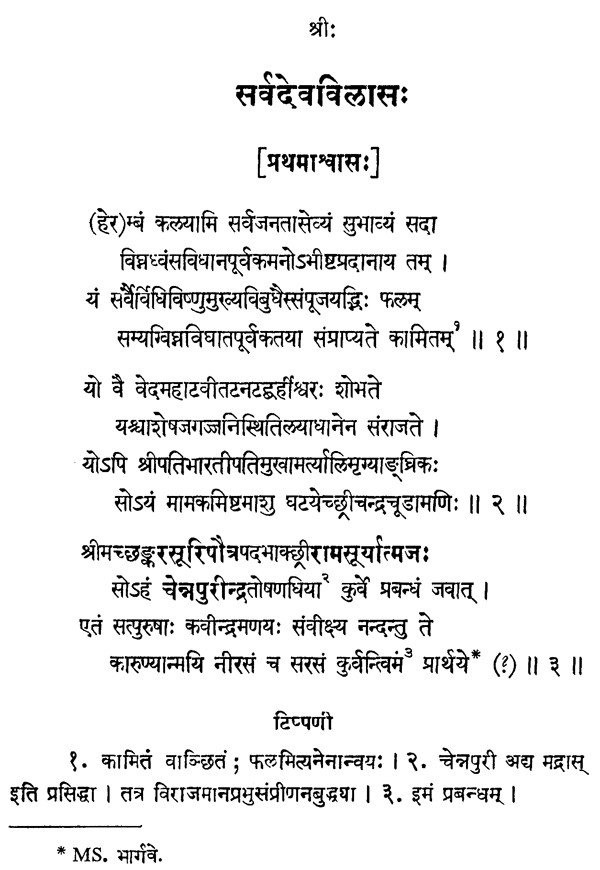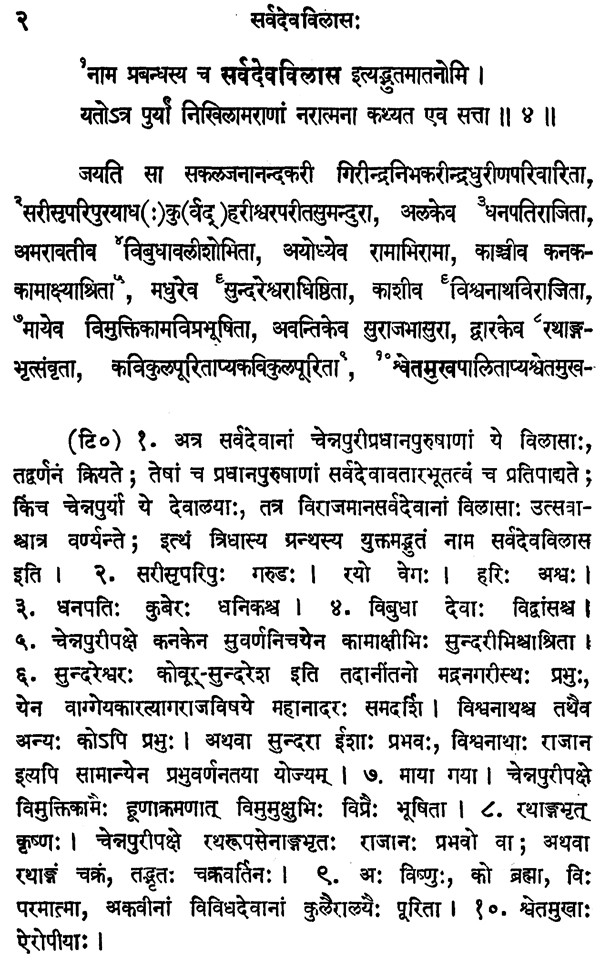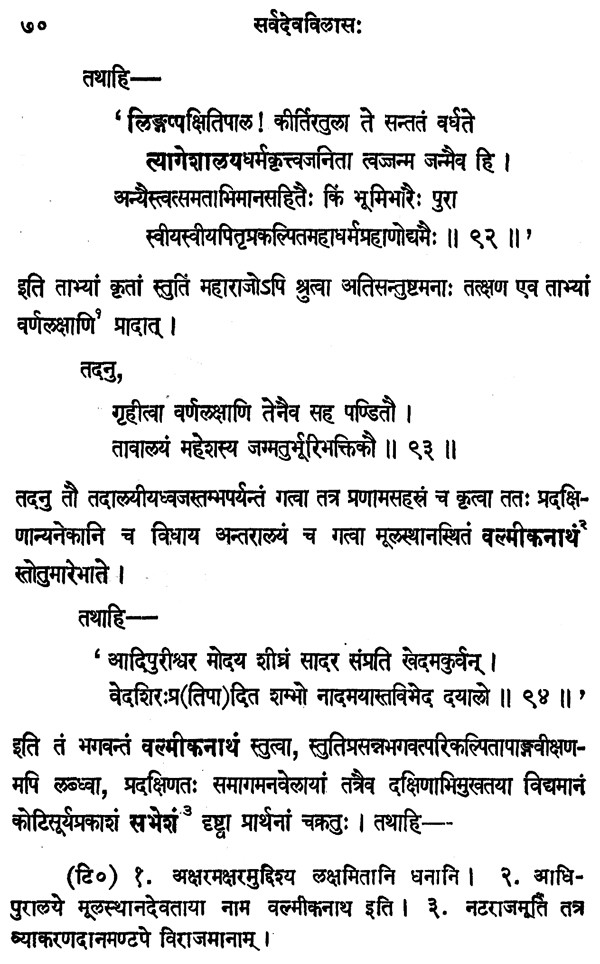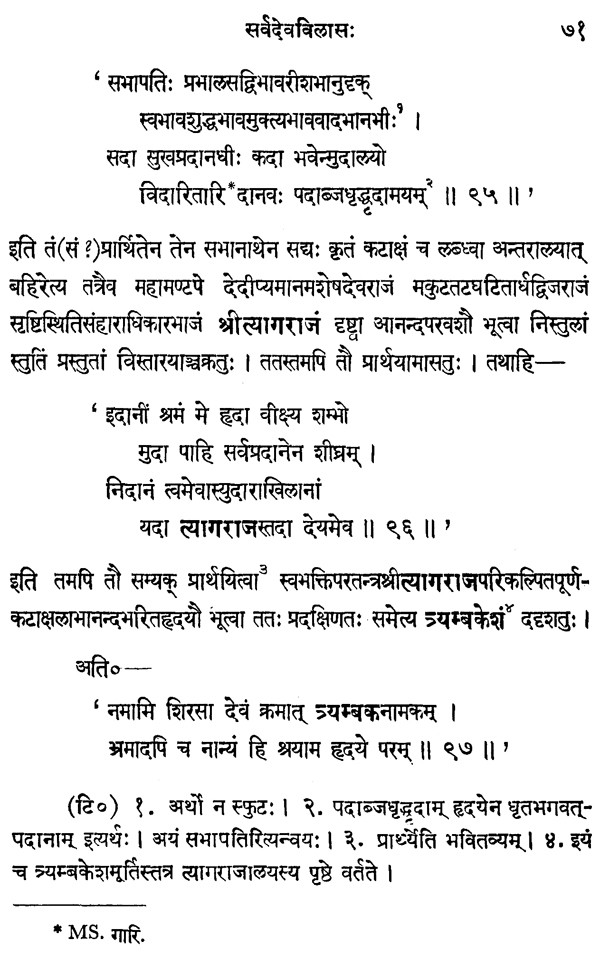
The Sarva Deva Vilasa
Book Specification
| Item Code: | MZX439 |
| Author: | V. Raghavan |
| Publisher: | Dr. V Raghavan Institute of Performing Arts, Chennai |
| Language: | SANSKRIT ONLY |
| Edition: | 2021 |
| Pages: | 186 |
| Cover: | PAPERBACK |
| Other Details | 8.50 X 5.50 inch |
| Weight | 210 gm |
Book Description
Thanks to the Adyar Library, the significant work Sarva-deva-vilasa, which has been preserved there in a manuscript, has been edited and brought to light. It is an interesting and instructive narration of the lives of the prominent men who lived in Madras City during the days of the East India Company. These illustrious persons were patrons of art and letters and the work refers to the poets, scholars, musicians and dancers patronized by them. They were also Dubashes engaged in flourishing trade with the Englishmen. They were trustees ~f many ancient temples. One notices from the particulars given here and elsewhere about Madras City that, when the British occupied it, it was far from being a mere fishermen's village as it is sometimes represented to have been. The present temple of Sri Cennakesava, after whom the City was named, stood originally in the area where the Fort was raised and there was a prosperous township around it. Madras and its suburbs were, as they are today, full of temples with their great Dharmakarta-s. The description of these celebrities of old Madras reveals how this City was full of wealth, piety, virtue and culture. The present City is an incorporation of the villages of Tondainadu around the sea coast. It must be very pleasing, particularly to the old residents of the City, that their predecessors and ancestors were magnificent leaders who contributed in no small measure to the growth of civilization and the upkeep of tradition and culture in the City. Publications of this kind will serve also to correct the, impression that the cultural associations of Tamilnad were concentrated in the southern districts. Let me congratulate Dr. Raghavan on his industry and genius and on bringing out a work which is unique in many ways.
I am particularly indebted to the Hon. Sri Bhaktavatsalam, Home Minister, Government of Madras, for writing a Foreword to this book. It is appropriate that he has associated himself with this publication for he is holding also the portfolio of Hindu Religious Endowments, including Temples and has already interested himself in the renovation and revitalization of the temple as a religious and cultural community centre. Madras and its outlying areas, as I have shown in the Introduction, are still noted for their innumerable temples; some of these, including a few of great antiquity and canonical association, are spotlighted in the present work; and with the management of one of these, Sri Bhaktavatsalam's family had been associated. It is hoped that this publication will kindle further interest in the study of Madras and Greater Madras from indigenous' sources.
The aristocrats who figure in this work appear in the role of patrons of art and letters; along with them are described the poets, scholars, musicians and dancers patronized by them. As these arts were closely related to the temples, the primary role in which these patrons are featured is that of the Dharmakarta or trustee in charge of the temple, its maintenance and its festivals.
We see here, therefore, members of that enlightened aristocracy which had long sustained the traditional culture in the land. Here we have a view of that Madras of which Saint Ramalingasvami sang” dharma migu Chennai "-" Madras full of virtue and piety".
We know from this work the names of many patrons who have been hitherto unknown; also, we hear of the names of scholars and artists, who, along with their patrons, had built up the cultural and artistic associations of the city. South Indian musicologists will see that this is perhaps the only known literary and historical document mentioning the names of some of the leading Carnatic musicians. Information is given also on many of the temples in the City and its outlying parts. An idea is gained here of the topography of the City as it was and the villages incorporating which it grew to its present form.
Book's Contents and Sample Pages











